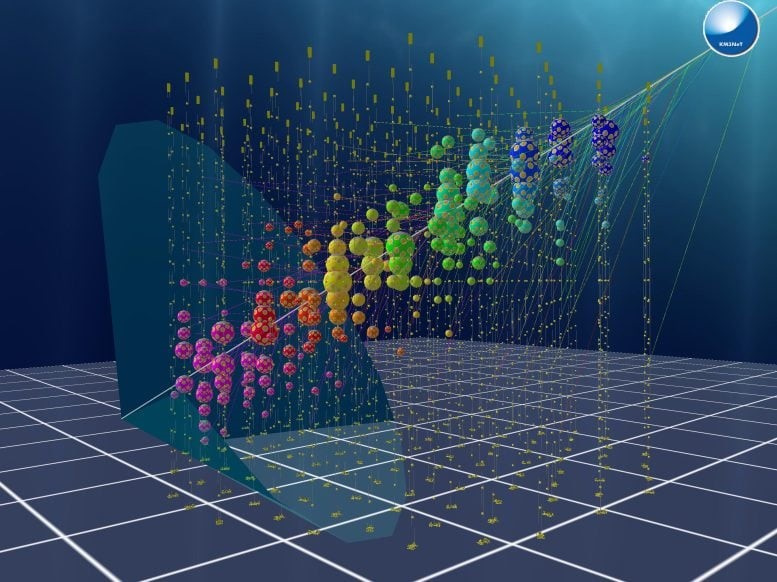Scientists Have Uncovered Quantum Signals Within Life Itself
Biological systems, once believed to be too chaotic for quantum effects, may actually be utilizing quantum mechanics to process information at speeds surpassing anything man-made. Recent research indicates that this phenomenon occurs not only in brains but throughout all forms of life, including bacteria and plants.
Schrödinger’s Legacy Sparks a Quantum Leap
Over 80 years ago, theoretical physicist Erwin Schrödinger delivered a series of influential lectures at Trinity College Dublin, blending modern physics with philosophical traditions like Schopenhauer and the Upanishads. These talks were later published in 1944 as "What is Life?"

Figure 1. Quantum Computation Embedded in Life’s Structure Enables Incredible Information Processing Speeds
Now, in the 2025 International Year of Quantum Science and Technology, Philip Kurian, a theoretical physicist and founding director of the Quantum Biology Laboratory (QBL) at Howard University, has expanded on Schrödinger's foundational ideas. Using quantum mechanics principles and recent QBL discoveries that show quantum optical properties in cytoskeletal filaments, Kurian has proposed a new upper limit on the total information-processing capacity of carbon-based life throughout Earth’s history [1]. His findings, published in Science Advances, also suggest a potential connection between this biological limit and the computational bounds of all matter in the observable universe. Figure 1 shows Quantum Computation Embedded in Life’s Structure Enables Incredible Information Processing Speeds.
Kurian stated, “This work links the fundamental pillars of twentieth-century physics—thermodynamics, relativity, and quantum mechanics—paving the way for a major paradigm shift in the biological sciences. It explores the feasibility and implications of quantum information processing in biological systems at ambient temperatures.” He added, “Physicists and cosmologists must grapple with these findings, particularly when contemplating the origins of life on Earth and beyond, evolving alongside the electromagnetic field.”
The Quantum Challenge in Living Systems
Quantum mechanics, typically considered applicable only at small scales, is highly sensitive to disturbances. This sensitivity is why quantum computers require ultra-cold temperatures, and why quantum properties are usually seen only in tiny objects like atoms and molecules. Biological systems, by quantum standards, are considered hostile environments—warm, chaotic, and composed of large components like cells. However, last year, Kurian’s team discovered a unique quantum effect in protein polymers in aqueous solution that survives under these challenging conditions at the micron scale. This effect could also offer insights into how the brain protects itself from degenerative diseases like Alzheimer’s and related dementias. Their findings have opened up new possibilities for quantum computing applications and presented a novel perspective on the connection between life and quantum mechanics.
In his solo-authored paper in Science Advances, Kurian explored three key assumptions: standard quantum mechanics, the relativistic speed limit imposed by light, and a matter-dominated universe at critical mass-energy density. “When combined with these simple premises, the experimental confirmation of single-photon superradiance in a common biological structure at thermal equilibrium unveils many new research avenues in quantum optics, quantum information theory, condensed matter physics, cosmology, and biophysics,” said Professor Marco Pettini of Aix-Marseille University and the CNRS Center for Theoretical Physics (France), who was not involved in the study.
Quantum Signals Traveling at the Speed of Light
The key molecule enabling these remarkable properties is tryptophan, an amino acid found in many proteins that absorbs ultraviolet light and re-emits it at longer wavelengths. Large networks of tryptophan form in cellular structures like microtubules, amyloid fibrils, transmembrane receptors, viral capsids, cilia, centrioles, neurons, and other complexes. The QBL's confirmation of quantum superradiance in cytoskeletal filaments means that all eukaryotic organisms can harness these quantum signals to process information.
In aerobic respiration, cells use oxygen to break down food and generate free radicals that emit damaging, high-energy UV light particles. Tryptophan absorbs this UV light and re-emits it at a lower energy level. The QBL study found that large tryptophan networks can do this even more efficiently and robustly, thanks to their powerful quantum effects. While biochemical signaling traditionally involves ions moving across cells or membranes in milliseconds, recent research has revealed that superradiance in cytoskeletal filaments occurs in about a picosecond—one millionth of a microsecond. These tryptophan networks could function as quantum fiber optics, enabling eukaryotic cells to process information billions of times faster than chemical processes alone would allow.
“The implications of Kurian’s discoveries are enormous,” said Professor Majed Chergui of the École Polytechnique Fédérale de Lausanne (Switzerland) and Elettra-Sincrotrone Trieste (Italy), who supported the 2024 experimental study. “Quantum biology, particularly the superradiant signatures observed through standard protein spectroscopy methods, guided by his theory, has the potential to open new avenues for understanding the evolution of living systems through the lens of photophysics.”
The Power of Life Without Neurons
By focusing on biological information processing at the level of neurons, many scientists overlook the fact that aneural organisms—such as bacteria, fungi, and plants, which make up the majority of Earth's biomass—also perform complex computations. These organisms have been on Earth much longer than animals, making them the primary contributors to Earth's carbon-based computation.
“There are signs of similar quantum emitters in the interstellar medium and on interplanetary asteroids, which could be precursors to the computational advantages seen in eukaryotic life,” said Dante Lauretta, professor of planetary science and cosmochemistry at the University of Arizona and director of the Arizona Astrobiology Center, who was not involved in the research. “Kurian’s predictions offer quantitative limits, extending beyond the traditional Drake equation, on how superradiant living systems enhance a planet's computing capacity. The remarkable properties of this signaling and information-processing mechanism could revolutionize the study of habitable exoplanets.”
Where Biology Meets Quantum Technology
Kurian's recent analysis has caught the attention of quantum computing researchers due to its implications for making quantum information technology more resilient in "noisy" environments. His work highlights the surprising connections between quantum computing and biological systems [2]. Kurian's discovery of UV-excited qubits in biological fibers suggests that nearly all life on Earth can compute with controllable quantum degrees of freedom, offering error correction cycles far beyond current quantum technologies. Quantum physicist Seth Lloyd praised Kurian’s efforts, noting that living systems perform far more powerful computation than artificial systems.
Life's Role in the Universe's Grand Scheme
Kurian emphasized that in the age of artificial intelligence and quantum computing, it’s crucial to recognize the physical laws that govern all behaviors, including those of living systems. Despite these strict limits on life's ability to observe and understand the universe, we still have the capacity to explore and uncover the profound order within it. He expressed awe at humanity's role in this ongoing cosmic story.
References:
- https://scitechdaily.com/scientists-just-discovered-quantum-signals-inside-life-itself/
- https://www.democraticunderground.com/122892427
Cite this article:
Janani R (2025), Scientists Have Uncovered Quantum Signals Within Life Itself, AnaTechMaz, pp.239















